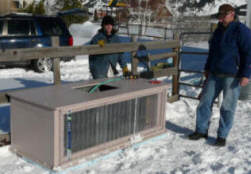
Search
The Renewable Energy site for Do-It-Yourselfers
Solar Stock Tank
Heater
|
This is a first cut at a stock
watering tank that is kept from freezing by a combination of
insulation and solar heating.
The idea for a simple and cheap
non-freezing stock tank came out of some discussions on the Homesteading Today
Alternate Energy Forum. This is a first rough cut at such a tank.
Around here, people with
horses and other livestock typically use galvanized metal stock tanks
for watering. In the winter to keep them from freezing, most people use
electric stock tank heaters like the one at the right.
|
|
| These heaters typically
include a thermostat that turns the heater on when the temperature gets
down toward freezing. The one at the right consumes 1500 watts
when its on. In cold climates, running these heaters can add
$100 to your electric bill during the winter. This seems like a pretty
expensive and greenhouse gas intensive way of preventing water freezing.
The tanks typically have no insulation, are in direct contact with the
air and the ground, and have a large water surface area that losses a
lot of heat through evaporation.
The idea is to see if there is a relatively simple and cheap and
easily built stock tank design that does not need a tank heater. |
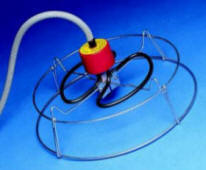
Typical evil electric tank heater |
First Cut Prototype
The basic goals of the prototype are
to: 1) reduce heat loss from the tank to the surroundings, and 2) capture enough
solar gain to offset the remaining heat loss. Ideally the tank will not
need an electric heater at all to keep the water from freezing.
The tank pictured below is a first
cut prototype that was made strictly from scrap lumber and stuff I had left over
from other projects -- total cost was zero dollars -- its just to see if the
idea works -- not to look nice.
The tank is a plywood box that is
open on top for drinking access. The inside of the plywood box is lined
with R13 rigid foam board insulation on east, west, and north sides as well as the bottom. The
south side of the tank is an un-insulated sheet of plywood that also acts as the
absorber for the solar collector.
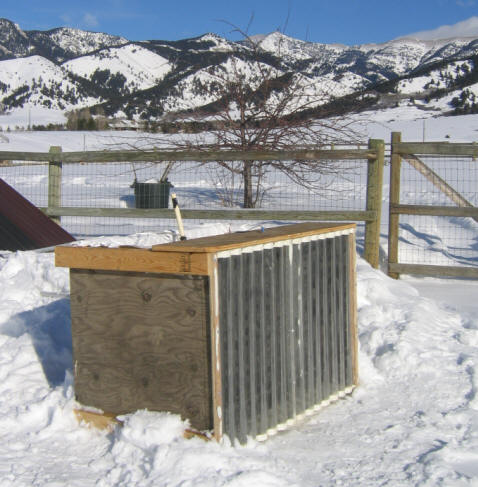
The box is lined with a waterproof
membrane to hold water. In my case I used some left over house wrap, but
EPDM pond liner would be a much better choice.
The water surface that is open to
heat loss is reduced with a floating insulation board lid that has hole in it to
allow for drinking. The drinking hole should be as small as the livestock
will live with.
The south side of the tank is
designed to collect some solar energy and transfer it into the tank water. The
piece of plywood that forms the south wall of the tank is painted black on the sun
side to absorb heat. The water side of the absorber wall is not insulated, so when
it heats up, it transfers some of the collected heat into the water.
Just in front of the south wall is a layer of SunTuf corrugated polycarbonate
glazing to reduce heat loss from the absorber.
This collector configuration has the
advantage of being very simple and cheap to build (about $1 per sqft of
collector area). On the down side, it will have fairly high heat loss at
night. The total insulation on the south (collector) side being only about
R2 or 3 -- of course this is still much, much better than a bare galvanized tank
wall.
With a little more work, the
collector could be turned into a thermosyphon design that would have a little
less gain during the day, but also much less loss at night and on cloudy days.
Cross section through the solar
stock tank

Sun shines through the
glazing (blue), and is absorbed by the south wall of the tank.
The sun side of the south tank wall is painted black to absorb heat.
Since the south wall of the tank is not insulated, much of the absorbed heat is
transferred through
the wall and into the water.
The other walls of the tank and the bottom are well insulated to reduce heat
loss.
A floating lid of some type with a drinking hold should be used to reduce heat
loss from
the water surface.
Construction
The tank walls are made from plywood
and framed with 2X4's. The south wall is glazed to form a solar collector.
|
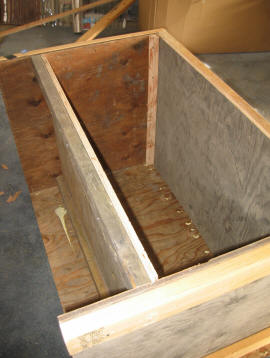
Water in back box, collector in front opening |

Scrap R-Board insulation on bottom and the
east, west, and north sides.
The insulation is 2 inch Atlas R-Board.
About R13 total. |
|
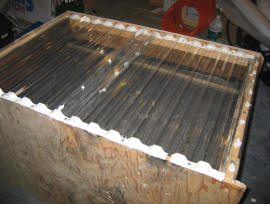
Stock tank sitting on its back with collector
glazing installed. The south wall of the tank
(behind the glazing) is painted black to
absorb sunlight. |
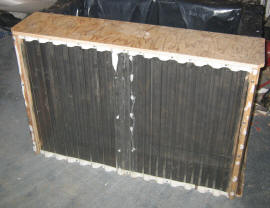
Looking at the collector side.
The south wall of the tank and the
absorber are the same sheet of plywood. |
Sitting in the yard.
Filled up 3/4 full. The house
wrap liner is not a good choice, but it is what I had on hand -- EPDM pond liner
would be much better.
The pole sticking through the insulation board lid has two temperature sensors
mounted on it -- one near the water surface and one about 2/3 of the way to the
bottom of the tank. The floating insulation lid should have a larger hole
for drinking, so I'm cheating a bit, but there is an about 1 inch open area all
the way around the floating lid.
Performance
The plot below shows the prototype
tanks performance over a three day period.
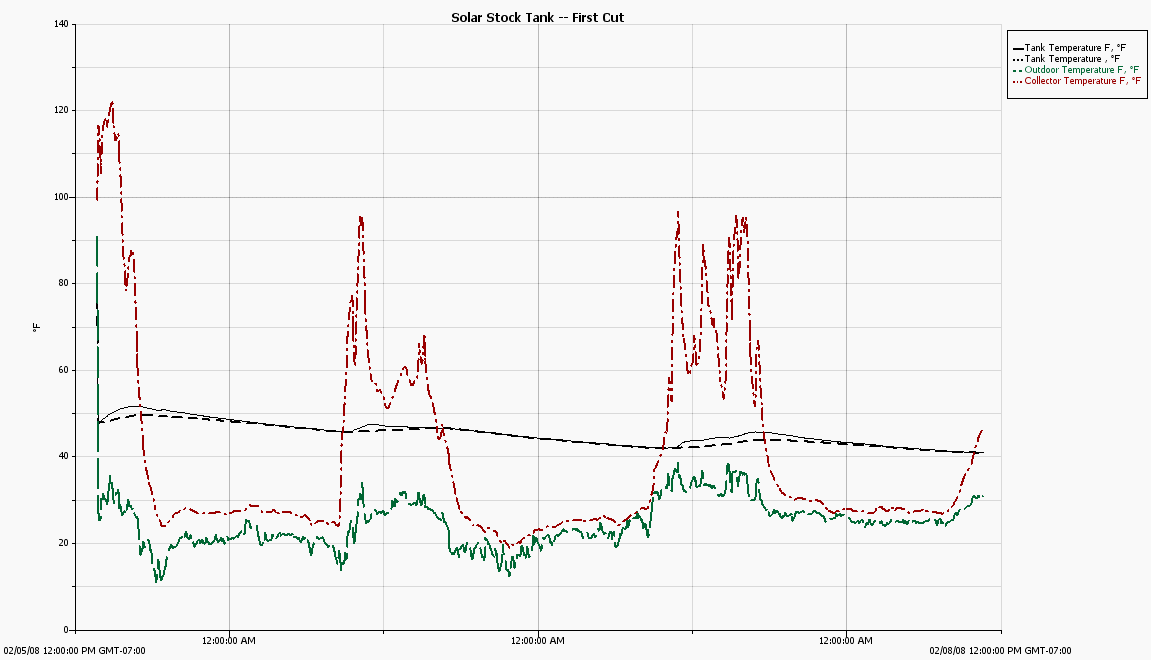
Prototype solar heated stock tank
over a 3 day period starting Feb 5, 2008.
The red trace is the air
temperature in the solar collector itself (sensor shaded from sun).
The two black traces are tank
water temperature (high and low)
The green trace is outside
ambient temperature
While there were a few sun breaks
in this time period, the weather was basically lousy with a lot more wind than we
usually have, and limited sun.
The water temperature starts out at
about 48F, and gradually trends down to about 41 F at by the third day.
There was no ice on the surface at all. No new water was added during this
period.
Outside temperatures were highs in
the low 30's to high 20's and lows down to around 16F.
Even with this limited amount of sun, the
tank temperature is able to recover a 2 or 3F degrees during the sunny periods
when the collector temperatures go up 100F or more. I would like to see
what it can do in a fully sunny day.
While the tank temperature is still
trending down toward freezing, the rate of drop is low, and will get even lower
as the difference between ambient and tank temperature is reduced.
Other factors that would effect
performance:
Adding new water to the tank from
time to time would tend to raise its temperature, and offset some of the
losses. Adding 1/4 of the tank capacity in new 50F water will raise
the tank temperature 3 or 4F. This alone would offset a lot of one
days drop under the weather conditions shown above.
The weather will certainly effect
performance. Long strings of cloudy and very cold days will really put
the insulation to the test, since there will not be any solar gain to offset
losses. Around here, that is uncommon, as the coldest weather usually
comes with clear skies.
The lid configuration will make a
difference. Having a large water surface exposed will result in rapid
drop in tank temperature. Some kind of floating lid with minimal sized
open drinking area would be good.
Of course, there is nothing to keep
you from using both the solar insulated tank and have the electric heater for
backup. That way, if you get a long string of really bad weather, the
electric tank will eventually come on and keep the tank from freezing, but the
run time on the heater will be a small fraction of what it would be on a
conventional tank.
Performance Update: Feb 15, 2008
The plot below shows temperatures for
the next few days.
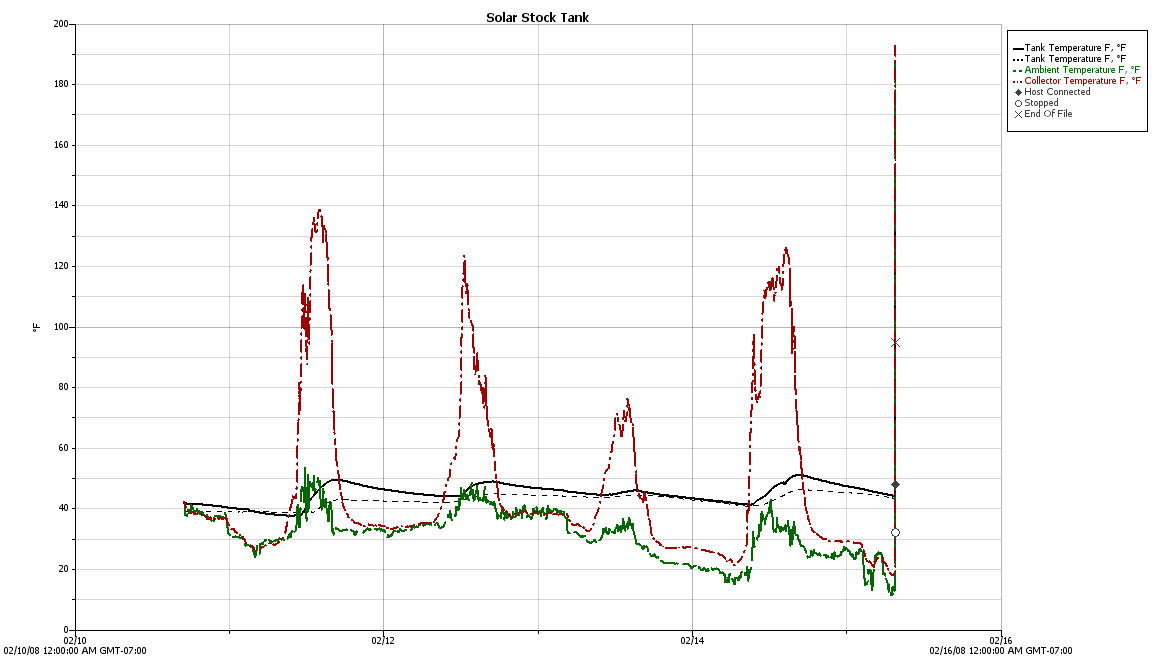
The tank water temp as stayed in the
40'sF, and there has been no surface ice.
The first couple days were warmer
than average with highs up to the low 40's and lows around freezing.
The last couple days were colder with
more sun on the 15th. Lows down to about 10F.
On sunny days, the collector
temperature goes up to the 120+F, and the tank water temperature warms up by a
good 10F.
So, this is a total of 10 days with
no ice and the tank water temperature well above freezing.
I am tempted to say that the concept
works pretty well thermally, at least under these weather conditions.
The performance would, of course, be
even better if new replacement water was being added from time to time.
Some issues of practically include:
-
Keeping the glazing from being
damaged by stock (maybe a small fence around the south end to protect it?)
-
Keeping the plywood tank from
being eaten by the stock (guess this depends on the stock?)
-
Practicality of limiting the
exposed surface area with the floating and insulating lid with a drinking
hole?
Some comments/suggestions from
Homesteading Today Forum on the tank:
Use two nested metal tanks with
foam in place insulation between them. For some climates this
might be enough without any solar gain, and it would be durable.
Solar gain could be included in this design by omitting the insulation on
the south side, and cutting in and glazing a solar window in the south wall
of the outer tank, then painting the south wall of the inner tank black.
Black tires floated in large
stock tanks will absorb enough heat to melt holes in the ice for drinking.
This is probably climate and weather dependant, but might be a nice simple
solution.
One person reported that the
Cobett ( http://www.cobett.com/ ) earth
heated stock waters work well. These fit in a hole that goes down
several feet, and use earth heat to keep the above ground waterer from
freezing.
There was a question on whether
the solar heated tank could be scaled to different sizes -- I think it
could, but small tanks probably present a bit more of a challenge because of
their greater ratio of surface (loss) area to tank volume.
More comments here:
http://homesteadingtoday.com/showthread.php?t=232090
If you have any comments/suggestions,
I'd like to hear them,
Gary...
Performance Update:
March 2, 2008
The plot below shows a period of 17
days ending on March 2, 2008.
I was away most of the time, but it
looks like first few days had some some sun, and the tank steadily gained
temperature each day.
Collector temps up in the 140F's and
water temperature rising about 13F during the day, and losing about 10F through
the night. The tank worked its way up to about 65F. Night air
temperature lows were around 12F, and daytime highs were as high as 50F.
The last few days, there was not much
sun, and the tank temps feel to about 45F -- always well above freezing.
This was a very stormy, windy period with several inches of snow.
Again, the tank seems to do pretty
well thermally, and would do even better if new water were being added each day.

Other Possibilities
It seems like just adding insulation
to any stock tank would greatly reduce the energy needed to keep it from
freezing.
Limiting the open water surface area
to the minimum required for drinking should also help a lot.
The solar collector does definitely
add heat to the tank, even on these more cloudy than not days we have been
having. The efficiency of the collector could probably be improved.
The plywood tank wall that acts as both tank wall and absorber has an R value of
about 0.6+ -- a metal wall would transfer heat into the tank better.
Perhaps a way could be worked out to
build this concept around a standard metal stock tank. One
long wall of the tank could be painted black and glazed for collection, and the
remaining walls and bottom could be insulated. This coupled with a
floating insulation lid with drinking hole should make for an efficient tank.
Any ideas?
Let
me know ...
Has anyone kept track of how many KWH
per day an electric stock tank heater uses in cold weather?
Here is one quote from a stock tank
heater user:
Stock Tank Heaters
Many of us are familiar with the standard heating element that goes directly
into the tank. They usually come with a thermostat to turn it off and on
with the rise and fall of the temperature. From first hand experience I can
tell you this is not the most economical method. Last year our electric
bill, for just one tank, hit $100 a month four months in a row. In addition
you’ve got concerns about refilling the stock tank, keeping it clean and
keeping the electricity away from the livestock. We’ve all heard horror
stories about a horse biting down on the electrical cord. However with
proper planning, these electrical devices can keep your livestock in water
all winter long. For safe operation, make sure you have a power supply with
a third wire ground. Cost for submersible electric heaters run between $30
and $60.
Gary Feb 8, 2008
August 31, 2008 -- added sketch


